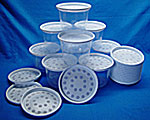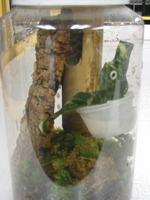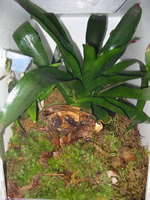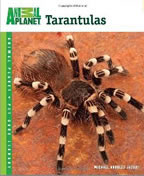Arboreal Tarantula Husbandry
© 2005-2013, Michael Jacobi and ExoticFauna.com/ARACHNOCULTURE magazine. This article was originally printed as "The Basics of Arboreal Tarantula Husbandry" in ARACHNOCULTURE 1(2) in May 2005. It is presented here in its entirety with only a few minor corrections and additions. The new ARACHNOCULTURE E-ZINE version with photos and some expanded content can be viewed here.
Introduction
Above the ground we live upon exists a whole different world. While most birds, many insects and one mammal are capable of flight, the majority of the creatures that dwell above land inhabit vegetation, from tall grasses and short bushes to the canopy of the highest trees.
The majority of theraphosid spiders, or tarantulas, live in or on the same ground where humans tread. Most dig burrows into the earth where they are protected from predators and live in a micro-environment often cooler and more humid than conditions at ground level. These species are called obligate burrowers. Other terrestrial tarantulas are more opportunistic and find shelter in burrows or scrapes created by other animals, natural crevices in the earth, or beneath leaf litter, fallen branches and other ground cover. Still other tarantulas have adapted to a lifestyle above the ground. These arboreal, or tree-dwelling, species have a lighter build with thinner bodies and longer legs with increased tarsal scopulation. That is, their legs are flatter and have thick setae ("hair") on the edges of their metatarsi and tarsi, the last two segments of their legs. This increased surface area at the ends of their legs allows them to effortlessly climb any surface, while their light build gives them increased agility and protects them from falls.
Arboreal tarantulas also differ in habits. Some live in low vegetation such as high grasses, bushes and palm fronds [e.g., Heteroscodra]. Others live in the trees themselves, seeking shelter among the leaves or epiphytic plants like bromeliads [e.g., Avicularia], or live in tree hollows or holes created by birds or insects [e.g., Poecilotheria]. Due to habitat destruction many Poecilotheria, the ornamental tarantulas or tiger spiders, are often found living in dead trees.
The specialization of the arboreal tarantulas requires that their captive husbandry be modified from that of obligate burrowing, opportunistic burrowing or terrestrial species. Their housing should be vertically-oriented — tall instead of wide — with retreats that approximate those of their natural habitat. Their habits and reduced tendency to dig or otherwise rearrange their enclosure makes them ideal tarantulas for beautiful naturalistic vivaria with live plants. This article details methods for creating a captive environment appropriate for the care and breeding of arboreal theraphosid spiders.
Simple Cage Construction
Rearing Containers
I raise early instar arboreal theraphosids in 20 or 50 dram clear vials, later moving young of 1.5 in [38 mm] legspan to 32 oz. [1 liter] clear Solo® deli cups. The approximate dimensions of the containers are: 20 dram — 1.5 in [38 mm] diameter x 2.7 in [68 mm] high; 50 dram — 1.9 in [48 mm] x 4.25 in [108 mm]; 32 oz. [1 l] cup — 4.5 in [114 mm] x 5.75 in [146 mm].
 (NOTE:
Since this article was originally written several years ago I have discontinued
using vials for all but the smallest of arboreal tarantula spiders. Now
preferred are the insect-lid style deli cups that are used for raising
fruit flies. These are like the aforementioned deli cups, but have a ventilated
lid with large diameter holes that are covered by a soft fabric. This
allows for increased ventilation while preventing spider escape or the
entrance of pest flies, etc. When using these well-ventilated containers
more careful attention must be paid to maintaining sufficient humidity,
but the flip side is that they dry quickly and stagnant conditions are
usually prevented. Even for small second instar Avicularia spiderlings,
I use the comparatively large 24 oz. insect cup and fill it 1/3-1/2 with
substrate like coco coir and then add a layer of damp sphagnum moss. These
containers are available from Superior Enterprise and other sources. See
the Product Listing at the end of this article.)
(NOTE:
Since this article was originally written several years ago I have discontinued
using vials for all but the smallest of arboreal tarantula spiders. Now
preferred are the insect-lid style deli cups that are used for raising
fruit flies. These are like the aforementioned deli cups, but have a ventilated
lid with large diameter holes that are covered by a soft fabric. This
allows for increased ventilation while preventing spider escape or the
entrance of pest flies, etc. When using these well-ventilated containers
more careful attention must be paid to maintaining sufficient humidity,
but the flip side is that they dry quickly and stagnant conditions are
usually prevented. Even for small second instar Avicularia spiderlings,
I use the comparatively large 24 oz. insect cup and fill it 1/3-1/2 with
substrate like coco coir and then add a layer of damp sphagnum moss. These
containers are available from Superior Enterprise and other sources. See
the Product Listing at the end of this article.)
Elsewhere in this article I write of the use of beneficial organisms living in the substrate, but in the very small confined space of the rearing container I prefer more sterile conditions and use a slightly damp mixture of coconut coir [e.g., T-Rex® Forest Bed™, Zoo Med® Eco Earth™] and horticultural vermiculite [3 parts to 1]. Many young arboreal tarantulas will burrow or create a silken tube that continues below the surface. This mix makes it easy for them to create these retreats. I add substrate to a depth of about 1/4 the container height and tamp it down firmly. A piece of cork bark is situated vertically in the cage and a small leaf or two of silk plant added. I do not use water dishes in these containers, but rather mist a spot away from the spider so that it may drink from the droplets. (See discussion of feeding and watering below.)
Plastic Gallon Jars [e.g., Rubbermaid®]
Clear plastic half-gallon and gallon jars, such as those made by Rubbermaid®, are excellent inexpensive containers for housing juvenile arboreal tarantulas or adults of some of the smaller species. (Note: The tall and rectangular clear cereal storage boxes are also very popular with arboreal tarantula keepers. They conserve on shelf space for those with large collections, and have handy lids with hinged smaller access doors. )
 Drill
several ventilation holes in the lid and use a soldering iron to put several
holes about 2 in [5 cm] above the jar bottom and another series about
3/4 the jar height up from the bottom on opposite sides of the container.
If you have problems with winged pests such as fruit or phorid flies affix
microscreen (available from biological supply house across the inside
each group of air holes. Alternatively, panty horsy or similar fabric
can be used. Insect screening is only effective against larger pests;
microscreen can be obtained from biological supply. As an alternative,
panty hose or similar fabric can be used.
Drill
several ventilation holes in the lid and use a soldering iron to put several
holes about 2 in [5 cm] above the jar bottom and another series about
3/4 the jar height up from the bottom on opposite sides of the container.
If you have problems with winged pests such as fruit or phorid flies affix
microscreen (available from biological supply house across the inside
each group of air holes. Alternatively, panty horsy or similar fabric
can be used. Insect screening is only effective against larger pests;
microscreen can be obtained from biological supply. As an alternative,
panty hose or similar fabric can be used.
I then add enough moderately moistened substrate to come up to about a half inch below the lower ventilation holes. I personally use garden soil (plain old dirt) or a 3:1 mix of coconut coir and coarse horticultural vermiculite, but top soil, untreated potting soil, sphagnum peat moss and vermiculite alone can also be used. Generally, I will add isopods, wood lice or other "ground cleaners" to the substrate. They will help with prey remnants, fungi, mold, etc. Some dry oak leaves and live moss can be added for both aesthetics and to contribute to the "living soil".
I then use a glue gun to affix a 2 oz [60 ml] condiment cup [e.g., Solo® or Dixie®] about 2/3 the jar height from the bottom, just below the upper ventilation holes. Two cups are needed - one will be glued to the side and become the holder, the other will be the actual removable water dish. After sufficient time has passed to allow the glue to set, I add the second water dish and put a silk plant leaf or flat rock inside to prevent prey from drowning. Then I add the finishing touches — the retreats for the spiders. These are made from bamboo, cork bark slabs or tubes and silk plants. The ratio of one to the other depends on the type of arboreal spider housed. For Avicularia I use plenty of silk plant and less wood; for Poecilotheria I primarily use bamboo and cork bark slabs or tubes and just use a touch of silk plant for decoration. A hollow bamboo piece with a round or oval entrance hole cut in the side is perhaps the ideal retreat for Poecilotheria as it resembles the tree holes they naturally inhabit. In between are the half bark/half plant habitats for Psalmopoeus, Tapinauchenius, Heteroscodra, Stromatopelma, etc.
This type of jar should provide plenty of ventilation while retaining some level of humidity. It is important to prevent damp conditions and additional air holes should be added as needed to ensure the earth becomes somewhat dry between "watering". Well fed spiders with access to fresh water will survive dry conditions quite well, whereas dampness and stagnant air will quickly lead to trouble. I re-moisten the substrate periodically by either misting or carefully overflowing the water dish when refilling. Misting has gotten a bad reputation in arachnoculture because for most it implies overly wet, stagnant conditions or irritating the spider. However, those are the result of improper or excessive misting. I avoid spraying the spider and lightly mist the side opposite of it and the water that trickles down the jar rehydrates the substrate. When there are silken tube retreats, such as with Avicularia, I try to allow droplets to form on the silk if I can avoid the spider.
10 Gallon Aquaria
 For spiders in excess of 4 in [10 cm] legspan I use 10 gallon aquaria oriented vertically [stood on end]. For the front I use ESU® screen covers with latching doors [ESU® #22105 (see product listing at end of article)]. I lay the screen top upside down on a table and use heavy duty clear packing tape to neatly cover all of the screen (sticky side out), except for the door. This will help prevent the rapid moisture loss and cover most of the screen, reducing the hazard of "tarsal claws" becoming stuck in the screen. If your tanks are housed in a humid area it might be necessary to remove some of the tape to provide good ventilation.
For spiders in excess of 4 in [10 cm] legspan I use 10 gallon aquaria oriented vertically [stood on end]. For the front I use ESU® screen covers with latching doors [ESU® #22105 (see product listing at end of article)]. I lay the screen top upside down on a table and use heavy duty clear packing tape to neatly cover all of the screen (sticky side out), except for the door. This will help prevent the rapid moisture loss and cover most of the screen, reducing the hazard of "tarsal claws" becoming stuck in the screen. If your tanks are housed in a humid area it might be necessary to remove some of the tape to provide good ventilation.
A water dish is added in the same manner as for the gallon jar. That is, it is glued 2/3-3/4 the way up one side so it close to a perching spider. It should also be located towards the front door to enable easy access during refilling or cup replacement. However, for the glass tanks I use All-Glass® aquarium silicone sealant instead of hot glue. Hot glue can still be used and it will allow you to cleanly remove the dish holder if necessary, but eventually the dish will fall because the glue doesn't bond as well to glass as plastic. Often I will find the perfect piece of cork bark and place it in the tank prior to gluing the dish holder so that I can position the dish up against the cork, which will later allow the spider to rest on the bark while drinking.
I use the same substrate — usually good old-fashioned dirt — and slope it towards the back so it is shallower in front and doesn't fall out before the cover (which is now the front) is added. Once again, dry leaves, moss and other forest litter can be added and live or silk plants and cork bark can be arranged as you choose. For Poecilotheria I wedge a 19.75 in [50.2 cm] length of 1.5-2 in [3.8-5 cm] diameter bamboo from bottom to top. An oval 1 inch wide and 2 inch high opening is cut into the bamboo about six inches from the top. (See discussion of retreats above.)
The final step is to attach the screen cover, which has already been lined from the inside with clear packing tape except for the door. Electrical tape is perfect for this: it stretches tight and blends in with the frame of the cover and the black plastic molding of the aquarium itself. If the taping is done neatly it will hardly be noticeable. Hold the cover tight against the tank and wrap across the top frame and around the tank until you overlap the entire front again and cleanly cut the tape. Repeat this process around the bottom.
Refer to my ARACHNOCULTURE E-ZINE CREATING AN ENCLOSURE FOR ARBOREAL TARANTULAS USING A VERTICALLY-ORIENTED 10 GALLON AQUARIUM for an illustrated and more comprehensive guide to creating this type of tarantula housing.
NATURALISTIC VIVARIA CONSTRUCTION
Whereas I house my Poecilotheria in the aforementioned 10-gallon aquarium setups, with silk plants and no lighting other than that of the room, I often create more elaborate vivaria for New World arboreal tarantulas, particularly Avicularia, which often create silk retreats among bromeliads or other plants and benefit from the natural humidity created by live plants.
 Live plants require light, and unlike basic cages containing fake plants, the first consideration with naturalistic vivaria will be the addition of a light source. A variety of plants will do well in low light conditions, but some artificial light will be required to keep any flora alive, including live moss ground cover. Because tarantulas are nocturnal and usually shun bright light, it is best to use small compact fluorescent tubes for lighting and use fixtures small enough to allow a darker area in part of the cage. Expensive high ultraviolet fluorescent tubes designed for reptiles are unnecessary for arachnids, and a number of bulbs available at home centers will be sufficient for lighting and plant growth, including plant and aquarium, "sunshine" or "daylight", and cool white bulbs. Incandescent bulbs should be avoided as they waste much of the energy in the form of heat, which is often undesirable for tarantula husbandry.
Live plants require light, and unlike basic cages containing fake plants, the first consideration with naturalistic vivaria will be the addition of a light source. A variety of plants will do well in low light conditions, but some artificial light will be required to keep any flora alive, including live moss ground cover. Because tarantulas are nocturnal and usually shun bright light, it is best to use small compact fluorescent tubes for lighting and use fixtures small enough to allow a darker area in part of the cage. Expensive high ultraviolet fluorescent tubes designed for reptiles are unnecessary for arachnids, and a number of bulbs available at home centers will be sufficient for lighting and plant growth, including plant and aquarium, "sunshine" or "daylight", and cool white bulbs. Incandescent bulbs should be avoided as they waste much of the energy in the form of heat, which is often undesirable for tarantula husbandry.
A thorough discussion of using live plants and substrate is beyond the scope of this article. In short, I like to use dirt on the bottom and slope it towards the back of the vivarium. Live plants can either be placed in this soil or left in small pots that will be hidden by the substrate. After adding the plants I cover the soil with a 1/2 in [13 mm] layer of damp orchid moss (sphagnum). On top of the orchid moss base is the third substrate layer — live moss. The orchid moss provides a bedding for the live moss to root in and wick moisture. Live moss placed directly on soil usually does not flourish and may die before long. Numerous plants can be used as long as they are rinsed of any pesticides or insecticides. Unless you have a great deal of experience with terrarium plants I recommend you stick to inexpensive and hardy plants from your local home center. Sansieveria, commonly known as the Snake Plant or Mother-in-Law's Tongue, requires a good deal of light, but has sturdy vertical leaves. Bromeliads such as Neoregelia or Aechmea are good, especially for Avicularia tarantulas. Good plants for lower light conditions include Pothos and Rhododendron.
Other decorations for naturalistic vivaria include those used in basic enclosures, such as cork bark, hollow logs and driftwood. When I collect live moss I also find a great deal of nice hollow limbs covered in moss and lichens. Natural-looking water dishes can be found at reptile shops and, with the help of aquarium-safe silicone sealant, attached to the side of the enclosure in a position where it is also supported from below by a vertical log or bark piece.
(NOTE: The above photo shows a naturalistic vivarium created using a custom white acrylic arboreal cage from Herpcages.com. Since this article was written both Exo-Terra® and Zoo-Med® have released glass terraria that are also excellent for creating naturalistic homes for arboreal tarantulas and I have extensively used the Exo-Terra® PT-2602 model that is eighteen inches tall and twelve inches square.)
Feeding and Watering
I list feeding and watering together because I consider them to be two halves of a very important whole. Nourishment and hydration go hand in hand, and animals of all kinds receive much, if not all, of the water their bodies use from what they eat. Feeding often will all but eliminate the risk of dehydration. A frequent error made in arboreal tarantula husbandry is over watering, whether by soaked substrate, heavy misting or reduced ventilation in an attempt to provide "sufficient humidity". Humidity is a measure of moisture contained in the air, not one of substrate wetting or air exchange. Natural humidity comes from live plants and evaporating water dishes, and hydration comes from food and drink. A well fed spider is a hydrated spider. Still, every tarantula large enough to have a dish should have one filled at all times. The housing suggestions above describe different ways of providing elevated water bowls for arboreal tarantulas. Only spiders housed in rearing containers need water provided by other means. Misting, when correctly done, provides a simulation of rainfall and allows the spiders to drink from droplets as they would naturally. There are two things to avoid when misting: spraying the spider and saturating the substrate. A light misting that allows droplets to form on the vivarium sides and contents is all that is needed. If the substrate has not dried 24 hours later, the quantity of water used when misting must be reduced.
Arboreal tarantulas will accept most of the standard feeder insects such as roaches and crickets. Catching winged insects, such as katydids and moths, can provide some variety. Many larger arboreal tarantulas will eat lizards (e.g., anoles) and treefrogs, and even descend to the ground to snatch a nestling mouse or rat. As mentioned above, I am a firm believer in keeping tarantulas hydrated by feeding often. Frequency of feeding will depend on the type and size of prey offered, but I like to offer food, in my case primarily roaches, to spiderlings two or three times a week, juveniles once or twice a week, and adults weekly. In general, spiderlings will accept prey the length of their body once they have molted a few times, but should be offered prey slightly smaller than that for the early instar stages, especially for tiny young like Tapinauchenius.
Ventilation
In an effort to elevate relative humidity many keepers resort to reducing airflow through the vivarium. This is neither good for the spider or any live plants. Moisture can be easily added, but not removed. The use of live plants, full water dishes and appropriate misting will provide natural humidity for tarantulas. Stagnant air with poor ventilation will lead to a host of problems, including mites, flies, fungus and mold. I periodically spray a fair rainfall into my cages, but the substrate is not overly wet the following day. If low humidity is a problem I recommend using a room humidifier to increase the moisture in the air flowing through the vivarium rather than making things wetter within it.
Heating
My advice for heating vivaria for arboreal tarantulas is the same as that for all tarantulas; only provide supplemental heat if needed. In other words, having a warm room or closet is preferable than using heat tape or pads to provide heat, and as long as your tarantula is feeding well it is probably warm enough. In fact, in most cases, ambient (room) temperature is sufficient, especially if that room contains some reptile cages giving off their own heat. Generally, the hobbyist will have access to an area that fluctuates from 68-80°F [20-27°C]. If additional heat is required and cannot be provided with a space heater around the cages, heat mats or tape sold in reptile shops can be used, but should be controlled by a thermostat. For vertically-oriented tanks I like the small adhesive-backed mats such as the small or medium Exo-Terra™ Heat Wave Rainforest mounted to the middle of the back of the vivarium.
A Brief Overview of Species
Arboreal tarantulas are popularly considered to be only for experienced keepers due to their supposed delicate nature when young and their speed and temperament With the exception of some species of Avicularia, arboreal tarantulas are best kept with minimal keeper interaction and no handling. It is true that all species are very quick and some are very nervous. It is also true that some have what is believed to be the strongest of all tarantula venom, particularly the tiger spiders of Poecilotheria and their fellow Old World genera Heteroscodra and Stromatopelma. However, with a few considerations in mind most hobbyists will enjoy keeping these spiders. One is that a cage with a number of good retreats will typically result in a calmer spider that will run to hide rather than stand in defense. In a bare cage a startled tarantula may indeed run towards an exit made by opening the cage, but a well-designed cage will provide security that will be chosen over flight. Another is that servicing a cage should be performed with rubber-tipped forceps. Uneaten food, cast skins, and water cups can easily removed from a safe distance with this essential tool.
There are a number of other tarantulas that either have arboreal tendencies when young, yet later become terrestrial or burrowing (e.g., Ephebopus, Hysterocrates gigas), and others that are semi-arboreal (Haploclastus, Cyriopagopus schioedtei, C. sp. "Singapore" (Lampropelma violaceopes) or occasional climbers, but they'll have to be covered in a future article.
New World
Avicularia — This genus contains some considerably docile species, such as A. avicularia and A. metallica, and are recommended for beginner arboreal tarantula keepers. Although jumpy, they are less so than many other congenerics (members of the same genus) and seldom bite when handled gently. Two species that generally have a more defensive nature and might very well bite are Avicularia braunshauseni and A. laeta. Avicularia are commonly referred to as "Pink Toes" or "Avics" and a number of species are available in the hobby including the technicolor A. versicolor and the big, woolly A. huriana. These spiders form silken tube retreats, often among vegetation, and quickly make nests in their cages. Avicularia spiderlings are usually easy to raise with the most common mistake being keeping them too damp. Avicularia may quickly dehydrate, but if they are fed often this risk is all but eliminated. A quick shower of a few droplets onto their silk retreat once or twice a week is recommended as well, but care must be taken to prevent constantly damp substrate.
Iridopelma — This genus contains three species. I. hirsutum is the one most prevalent in arachnoculture, but it is far from common. Care and habits are similar to that of its cousin Avicularia. It is a nervous, fast-moving species.
Pachistopelma — This genus contains two small species that are not common in captivity.
Psalmopoeus — These spiders get large and usually have an attitude to match. From the orange-accented, olive P. cambridgei to the Halloween-colored P. irminia to the smaller and more somberly colored P. pulcher and P. reduncus, these are impressive and beautiful display spiders. If disturbed they will quickly rear-up and not hesitate to strike, but if left alone they tend to settle down and remain in their retreats during cage maintenance.
Tapinauchenius — These are some of the fastest of all tarantulas. With the exception of T. gigas, they are generally smaller than other arboreal tarantulas except Pachistopelma and some dwarf species of Avicularia. Lacking the gaudy coloration of some of the other tree-dwelling theraphosids, "Taps" have a velvety sheen that ranges from bronze to silver to mahogany to purple. Spiderlings are small and require close attention. They should be fed often with small insects until they have molted several times.
OLD WORLD
Encyocratella olivacea (formerly Xenodendrophila gabrieli) — This Tanzanian arboreal has only been recently described and only a small number have entered the hobby.
Heteroscodra — Only H. maculata is commonly found in the hobby. This grey ghost tends to build silk retreats towards the bottom of the cage, although some will spend a fair amount of time perched high on a vertical piece of bark.
Stromatopelma — Similar to Heteroscodra in habits, albeit a bit more high-strung. The "red" color morph found in the hobby is an incredibly beautiful spider with feathery setae that gives it the common name of "Feather-leg Baboon Spider".
Poecilotheria — The queen of arboreals, at least to this keeper. Many keepers fear these spiders because of their reputation for speed and the extremely painful bites reported by a number of hobbyists. P. regalis is the "classic" species of this genus and possibly the best species for the beginner, who should avoid the more easily agitated species like P. fasciata and P. ornata. However, when inside their cages and not provoked these tend to be among the calmer of the arboreals, much more so than Psalmopoeus irminia, for example. These are the largest of the arboreal tarantulas, with Poecilotheria ornata and P. rufilata capable of leg spans in excess of 8 or 9 in [20 or 22.5 cm]. Poecilotheria are among the most hardy of the arboreal tarantulas, tolerating somewhat dry conditions if provided with water and frequent food. Care should be taken that the three montane species [P. rufilata, P. smithi and P. subfusca] rare not kept dry for extended periods and are not exposed to temperatures exceeding that of a comfortable room.
Product Listing
ESU® screen cover with door, model 22105 — www.esuweb.com
Exo-Terra® Glass Terrarium & Heat Mat — www.exo-terra.com
Vials — www.thorntonplastics.com
Deli Cups — www.superiorenterprises.com
Plants — www.tropiflora.com
T-rex® Forest Bed™ — www.t-rexproducts.com
Zoo-Med® Eco Earth™ — www.zoomed.com
Herpcages.com - www.herpcages.com
SEE ARACHNOCULTURE E-ZINE ARTICLES FOR MORE INFORMATION!
- BASICS OF ARBOREAL TARANTULA HUSBANDRY
- CREATING AN ENCLOSURE FOR ARBOREAL TARANTULAS USING A VERTICALLY-ORIENTED 10 GALLON AQUARIUM
- EXPERIMENTAL HOUSING FOR MONTANE POECILOTHERIA
SUGGESTED READING
Allison, M. 1996. The keeping of Avicularia sp. in captivity. Journal of the British Tarantula Society 11(2): 55-57.
Gabriel, R. 1998. Avicularia minatrix — some notes on husbandry, breeding & rearing. Journal of the British Tarantula Society 14(2): 47-49.
Hull-Williams, V. 1988. Captive management and breeding (Poecilotheria regalis). Journal of the British Tarantula Society 4(2): 23-25.
Jacobi, M. 2005. Experimental housing for montane "tiger spiders": Poecilotheria smithi and P. subfusca: a preliminary report with comments on P. rufilata. ARACHNOCULTURE 1(1): 30-41.
Ross, L.K. 2001. Captive care and maintenance of arboreal baboon spiders (Stromatopelma and Heteroscodra). Journal of the British Tarantula Society 16(3): 95-102.



